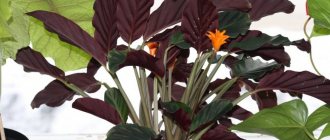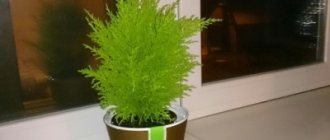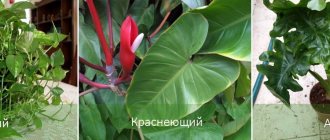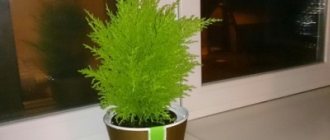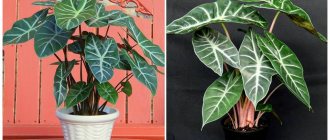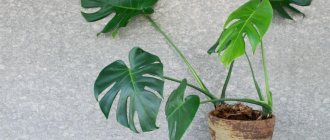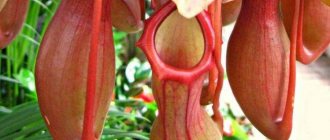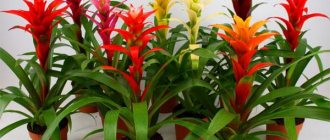Author: Elena N. https://floristics.info/ru/index.php?option=com_contact&view=contact&id=19 Category: Houseplants Published: August 17, 2018Last edits: January 11, 2021
- Diseases and their treatment
- Golden Aphelandra (Aphelandra aurantiaca)
Aphelandra, or Aphelandra (lat. Aphelandra) is a genus of flowering plants of the Acanthus family, common in tropical areas of America. The name of the genus is formed from two roots of the Greek language, means “simple man” and explains the presence of simple single-locular anthers in plants of this genus. There are about two hundred species in the genus, some of which are common in indoor culture.
Planting and caring for aphelandra
- Flowering: from spring to late autumn or early winter.
- Lighting: in winter - bright sunlight, the rest of the time - bright diffused light.
- Temperature: during the growing season – 20-25 ºC, during the dormant period – within 18-16 ºC.
- Watering: regular, the substrate should be slightly damp all the time.
- Air humidity: high, requires frequent spraying with water from a fine spray or keeping on a tray with wet pebbles.
- Feeding: from the beginning of the growing season until the end of flowering - once every 10 days with a solution of complex mineral fertilizer for flowering plants.
- Dormant period: from the end of flowering until spring.
- Transplantation: young plants - annually in spring, adults - once every 3-4 years.
- Reproduction: seeds, leaf and apical cuttings.
- Diseases: leaf mold, verticillium wilt.
- Pests: scale insects and aphids.
Read more about growing aphelandra below.
Periodization
For home care, summer flowering is typical, after which aphelandra will delight you for a month and a half. Then we recommend removing the inflorescences - otherwise, fruiting may kill the plant.
After inflorescences, aphelandra will be in “resting mode”. For proper care during this period, move the flower to a bright place.
The temperature regime was mentioned a little above, and after the next watering, make sure that the soil is dry from the previous time. In spring, the flower must be in a permanent place.
Botanical description
In nature, aphelandras are herbaceous perennials or low-growing shrubs up to two meters high, but in cultivation they grow no higher than 70 cm. The leaves of aphelandras are large, dark, shiny, sometimes smooth, sometimes prickly, with wide median and lateral veins, painted white , cream or silver color. Flowers up to 2 cm in diameter with large and hard bracts, often brightly colored, are collected in terminal cone-shaped or spike-shaped inflorescences and have a two-lipped corolla - lilac, red, yellow or orange; The lower lip of the flowers is three-lobed, the upper is two-toothed.
The homemade aphelandra flower is valued not only for its beautiful and long-lasting flowering, but also for its spectacular large leaves.
Temperature
As we have already mentioned, domestic aphelandra is quite capricious and requires some care. First of all, take care of the absence of drafts and compliance with temperature parameters.
For example, in winter, fifteen degrees of heat is enough, in the demi-season period - about twenty. During the summer months, keep the flower at about 24 degrees Celsius.
Caring for aphelandra at home
Growing conditions
The aphelandra plant comes from the tropics, and for its normal growth and development it is important to create conditions close to natural. How to care for aphelandra at home? This flower needs bright lighting: in winter, a window oriented to the south will suit it, and in the warm season, when the rays of the sun are especially hot, aphelandra needs bright but diffused light. A flower can spend its summer holidays in the fresh air, but only with mandatory protection from direct rays, wind and rain.
- Photos of small-leaved and coinifolia Pilea
In the photo: Growing aphelandra at home
The heat-loving aphelandra flower grows well at the usual temperature for a human home - 20-25 ˚C. In winter, the plant is more comfortable in a slightly cooler temperature, but it should not be lower than 16˚C.
The fast-growing aphelandra begins to lose its lower leaves with age and loses its attractiveness. To give the plant the shape of a lush bush, the ends of its shoots are pinched from time to time.
Adult aphelandras are pruned at the end of February, before the start of the new season, leaving only stumps 30 cm high from the shoots. In order for the aphelandra to quickly restore its normal appearance, it must be sprayed frequently after pruning.
Watering
Aphelandra is moisture-loving, so the substrate in its pot should be slightly moist all the time, but frequent and severe waterlogging is unacceptable. Watering is carried out with boiled, melted water, passed through a filter, or simply settled, non-cold water.
In the photo: Blooming yellow aphelandra
The aphelandra houseplant, like other inhabitants of tropical forests, needs air saturated with moisture. To increase the air humidity in the room, you can use a humidifier powered by an electrical network, but it is cheaper to simply spray the air in the room with a fine spray or keep a flower pot on a tray with wet pebbles or expanded clay.
Fertilizer
Like any other indoor plant, aphelandra needs to be fertilized. Fertilizing begins in the spring and stops when the plant finishes blooming. Mineral complexes are used as fertilizers for flowering indoor plants. The frequency of feeding is 2-3 times a month. In winter, aphelandra does without fertilizers.
- Arctotis: growing from seeds, types and varieties
About growing aucuba at home
Transfer
Caring for aphelandra at home involves regularly replanting it. Young plants are transferred from an old pot to a new one every spring, and for older specimens it is enough to change the pot once every 3-4 years. Aphelandra is grown in a soil mixture of equal parts of leaf soil, peat and sand, adding a little coconut fiber and charcoal, but first the pot is filled to a third of its volume with drainage material.
In the photo: Beautiful aphelandra leaves
Bloom
At home, aphelandra can bloom for a very long time: from spring to early winter. The duration of flowering usually depends not only on the conditions created for the plant, but also on the type and variety of aphelandra. The average flowering time is two months. Wilted inflorescences must be removed from the plant.
In order for the aphelandra to bloom well next year, it is necessary to provide it with a period of relative rest after flowering: move it to a cooler, but no less bright place, reduce watering and completely stop feeding.
Transfer
Young plants under 3 years of age grow especially actively, so they need to be replanted annually. Adult aphelandras should be replanted every 3-4 years. The optimal period for this is the beginning of the growing season (April-May). You can determine the need for replanting by the roots protruding to the surface or, conversely, they can look out through the drainage hole of the pot.
Transshipment procedure:
- It is advisable to water the plant a day or two in advance to avoid the earthen clod from falling off.
- Place the plant on the covered floor. By tapping on the walls of the pot, separate the earthen lump. Help push it out of the pot with a wooden stick.
- Separate the drainage from the edges of the roots or trim the parts that have grown into the drainage materials.
- Remove some soil from the top of the ball.
- Inspect the roots for damage and disease. If the plant is healthy, continue transshipment.
- To ensure good air exchange and retain moisture in the soil, expanded clay drainage must be placed at the bottom of the pot.
- The optimal amount of expanded clay drainage is 1/4 of the pot
- Pour a little substrate onto the bottom and compact it.
- Place an earthen ball with roots in the pot.
- Add the substrate between the walls of the pot and the earthen lump, pressing down with a wooden stick.
- Add soil from above to the desired height.
- Water lightly.
If Aphelandra has reached enormous sizes and replanting is impossible or impractical, you can replace the top layer of soil in the pot annually or grow a new plant from a shoot or cuttings.
What kind of soil does the plant need?
With a very acidic soil mixture (pH less than 5.5), the leaves of aphelandra turn yellow, the flowers become smaller, and the perianth withers. When the soil mixture reacts alkaline (pH more than 7.0), the plant’s development stops and eventually it dies.
Recipes for soil mixtures for growing aphelandra:
- 4 parts leaf soil + 1 part peat (brown) + 1 part sand;
- 1 part leaf soil + 3 parts peat (brown) + 1 part moss + 1 part sand + 10% charcoal + 2 tbsp. spoons of superphosphate (per 10 liters of mixture);
- 4 parts leaf soil + 2 parts humus + 1 part moss + 1 part vermiculite + 10% charcoal + 2 tbsp. spoons of bone meal (per 10 liters of mixture);
- 8 parts leaf soil + 5 parts turf soil + 2 parts peat (brown) + 2 parts coniferous soil + 2 parts charcoal + 1 part vermiculite;
- 3 parts turf soil + 1 part coniferous soil + 1 part brown peat + 1 part humus + 1 part vermiculite + 1 part sphagnum;
- 1 part turf soil + 2 parts leaf soil + 1 part brown peat + 1 part moss +1 part vermiculite +1 part sand.
Note! After preparing the mixture, before using it, it is MANDATORY!!! needs to be sterilized.
Reproduction of Aphelandra
At home, aphelandra can be propagated both by seed and vegetatively - by apical or leaf cuttings.
Aphelandra seeds are sown in February or March in a substrate consisting of leaf soil (4 parts) and sand (1 part). For speedy seed germination and further development of seedlings, maintain a temperature of 20-22 ˚C in the room. The process will go faster if you use mini-greenhouses with bottom heating. Grown seedlings dive into a substrate consisting of equal parts of turf soil, sand and leaf soil. With good care, seedlings can bloom in the first year.
How to plant and care for asparagus at home
For cuttings, cut mature annual shoots 10-15 cm long with two leaves. They do this from March to May or in December-January. For more reliable and faster rooting, the lower sections of the cuttings are treated with Kornevin, Heteroauxin, succinic acid or another root former, after which they are planted in a cutting box with bottom heating under a transparent cap. The process of root regrowth should take place at a temperature of 20-25 ˚C with regular ventilation and spraying of the substrate. Stem cuttings root in one and a half to two months, and apical cuttings in 2-4 weeks. Cuttings with formed roots are planted in pots with drainage and a substrate of peat, leaf soil, humus and sand (1: 1: 1: 0.5) and grown in the same conditions as adult aphelandras.
In the photo: Blooming wild aphelandra
In autumn or winter, you can cut a developed, but not yet old, leaf with an axillary bud from the plant, preferably from shoots that have not bloomed, and plant it for rooting in a mixture of sand and peat, covering it with a transparent cap on top. Keep the cuttings at a temperature of 20-25 ˚C, regularly ventilating and spraying the substrate with water.
- Feeding indoor plants
Since aphelandras stretch out and shed their lower leaves with age, the best way to restore the decorative appearance of old plants is to take cuttings.
Red spider mite
A visible cobweb appears on the leaves or under them. The leaves turn yellow and fall off.
The spider mite is a very small (0.1 - 0.3 mm), translucent, sucking arthropod, greenish or yellowish in color, difficult to see with the naked eye. The larvae are so small that they are completely invisible. Settles on the underside of the leaves of almost all indoor plants growing in warm, dry air.
Spider mites are the most dangerous pest of indoor plants. A thin web on the plant indicates a spider mite infestation. The leaves of plants damaged by mites become marbled, covered with thin cobwebs, turn yellow and fall off prematurely. Plants suffer, lose their healthy appearance, and develop poorly.
Control measures: Treat aphelandra with derris, malathion or a systemic insecticide. Regularly ventilate the room, humidify the air and spray the plant with water at room temperature. Inspect the plant periodically.
Centipede
Millipedes (Symphila) jump on the surface of the soil when watering. These whitish or dark brown wingless, caterpillar-like, relatively harmless insects sometimes gnaw on the stems of young plants.
Control measures : water the soil with rogor.
Verticillium wilt
Verticillium wilt causes discoloration and wilting of the lower leaves, and then the entire plant. The disease is transmitted through the substrate.
Control measures: destroy the diseased plant.
Pests and diseases
Diseases and their treatment
Aphelandra is rarely affected by diseases, but difficulties with its cultivation still occur. For example, the tips of the leaves of a plant often dry out, and this may indicate low air humidity and too high a temperature in the room. You need to start spraying the air or place the flower on a tray with wet pebbles.
Sometimes aphelandra is delayed in flower formation, and the reason may be insufficient lighting or lack of nutrients in the substrate. Feed the plant with complex fertilizer and move it closer to the light. If necessary, arrange additional artificial lighting for the aphelandra.
Sometimes readers ask why aphelandra leaves fall off. If the plant suddenly begins to lose leaves, this may be the result of irregular watering and frequent drying out of the substrate in the pot. Direct sunlight or watering the plant with cold water can cause leaves to fall off. However, for older aphelandras this is a normal process.
In the photo: Pink aphelandra blooms
From constant waterlogging, aphelandra can be affected by leaf mold. Cut out the diseased areas with a sharp, sterile instrument, grabbing healthy tissue, and treat the plant leaf by leaf with a fungicide solution.
But the most dangerous thing for aphelandra is verticillium wilt, which can be caused by a substrate infected with a fungus. As a result of the development of the disease, the vessels of the plant are affected, and it is impossible to save the aphelandra. To avoid infection, sterilize the soil before planting.
Pests and their control
Most often, aphelandra on the windowsill is affected by aphids and scale insects. These are sucking pests that feed on the cell sap of leaves and young shoots. If the number of pests is small, it will be enough to wash the aphelandra in the shower with soap, protecting the soil in the pot from dirty water getting into it. However, scale insects must first be collected from the leaves with a cotton swab dipped in soapy water or alcohol. But if the pests have managed to breed, you will have to treat the plant with a fungicide - Actellik or Fitoverm, and quite possibly more than once.
How to choose a flower in a store?
The plant should have hard, glossy leaves without brownish tints, without limp leaves.
- Spring and summer are best for purchasing;
- The plant should not have any defects;
- the foliage should be strong and rich in color;
- It is advisable to choose a symmetrical plant; asymmetry may indicate that the bad parts of the flower have been cut off;
- inspect the back side of the leaves, pests often settle there and you can see damage from them;
- It is not desirable to have a root system on the soil surface;
- It is worth purchasing a plant that has blossoming flowers and buds;
- the more young leaves, the better;
- there should be no white coating on the soil;
- Avoid specimens standing in a draft.
Types and varieties
Golden Aphelandra (Aphelandra aurantiaca)
Or orange aphelandra - a low-growing evergreen shrub with a thick and juicy, slightly reddish stem, which becomes woody over time. The leaves of this species are entire, glabrous, silver-green, up to 25 cm long, oval-oblong, oppositely located, pointed at the apex. Bright orange flowers with green bracts are collected in a tetrahedral spike-shaped inflorescence up to 15 cm tall.
The variety most often grown in indoor culture is:
- Retzl's aphelandra is a plant with large silver-white leaves and inflorescences up to 15 cm long of red-orange flowers. This plant bears fruit easily, so it can be propagated by seed.
In the photo: Golden Aphelandra (Aphelandra aurantiaca)
Aphelandra squarrosa
Or Aphelandra squarrosa is also an evergreen low shrub. It has bare fleshy reddish shoots and variegated sessile oval-elliptical leaves up to 30 cm long. The upper side of the leaf blade is glossy, with silvery-white veins visible on it, creating an ornament on a dark green background. The underside of the leaves is lighter than the top. The flowers of this plant are two-lipped, tubular, collected in quadrangular apical spike-shaped inflorescences up to 30 cm long. Bracts of bright orange leaves set off the yellow flowers. The flowering of Aphelandra protuberans lasts from early summer until November.
The following plant varieties are popular:
- Aphelandra Louisa is a flower with a rounded reddish stem and oblong leaves up to 22 cm long, on which yellow or silver-green veins are drawn on a green background. The flowers of this plant are canary yellow and the bracts are dark yellow with a green vein;
- Aphelandra Leopolda - a plant with bright orange inflorescences;
- Aphelandra Denmark is a variety with yellow inflorescences and greenish-white veins on dark green leaves.
How does a flower look in the interior?
Aphelandra is valued for its large, beautiful leaves and long-lasting flowering.
Aphelandra is a fast growing plant. It can be used as a bright and attractive single plant, as well as in compositions where large, beautiful leaves with light veins will stand out against the background of less impressive representatives of other decorative leaf species.
Aphelandra is recommended for landscaping small-sized residential and office premises, for decorating bay windows and loggias, it is popular as an exhibition plant.
Possible difficulties during cultivation
Although aphelandra is relatively resistant to diseases and insect pests, sometimes some problems arise when maintaining it.
Doesn't bloom
If a lack of color occurs in Aphelandra protuberans, this is due to failure to comply with the necessary growing conditions. This variety requires a period of rest after flowering - for this, the temperature and the amount of watering are reduced.
You can also find out what to do if your geranium doesn't bloom.
In other cases, the reason for the lack of color is a lack of nutrients in the soil. To eliminate this problem, it is necessary to apply appropriate fertilizing.
Flowering may also be absent due to lack of light.
Diseases
Basically, aphelandra is susceptible to fungal diseases that arise due to excessive watering, as well as when using non-disinfected soil for planting and lack of drainage.
Let's consider the main ones:
- Corinespora. This is a fungal disease, which is expressed in the appearance of black-brown spots on the leaves, they gradually become wrinkled and die. To combat the disease, all diseased leaves are removed and a fungicide is applied.
- Leaf spotting. It is expressed in the appearance of brownish wet spots on the leaves. The cause is often too high humidity during rooting of cuttings and contaminated soil. To eliminate this problem, the affected areas of the plant are removed, the soil is changed, and fungicides are treated at least 3 times.
- Root rot. The main symptom of the disease is wilting and drying out with sufficient watering. Occurs due to poor drainage and excess moisture at low temperatures. In this case, it is necessary to replant with pruning of damaged roots, as well as treating them with the chemical “Fitospor”.
- Leaf mold. Appears as dark spots on the leaves. For treatment, leaves damaged by the disease are removed and treated with a fungicide.
- Blackleg. It is recognized by identifying black and thinned areas on the stem at the base, while the leaves wither and die. The reasons are often lack of ventilation, elevated temperature, excessive watering, and lack of lighting. To solve this problem, they are treated with a fungicide and transplanted into disinfected soil.
- Verticillium wilt. This fungal disease manifests itself as leaf wilting; infection occurs through the soil. Unfortunately, if this disease is detected, the indoor flower must be disposed of so as not to infect neighboring plants.
Homeland of the plant
Aphelandra protruding is an evergreen shrub from the Acanthus family. There are about 170 species. Common in the American tropics and less common in the subtropics. Under natural conditions it reaches a height of two meters, at home – no more than 1.3 meters. This heat-loving plant received a lot of moisture in the wild, so growing it at home will not be easy.
Aphelandra - an ornamental tropical plant
What you should know before buying aphelandra
| Mature plant size | Up to 1.5 meters in height, and leaf length 0.7 meters |
| Lifespan | Perennial plant, but requires renewal every 2 years |
| Bloom | Blooms from June to September; inflorescences are bright, orange, raspberry, scarlet, lemon in color |
| Aroma | Without smell |
| Safety | All parts of the plant are poisonous |
| Difficulty of care | Difficult for beginners |
| Uniqueness | Rare view |
| Where can I buy |

